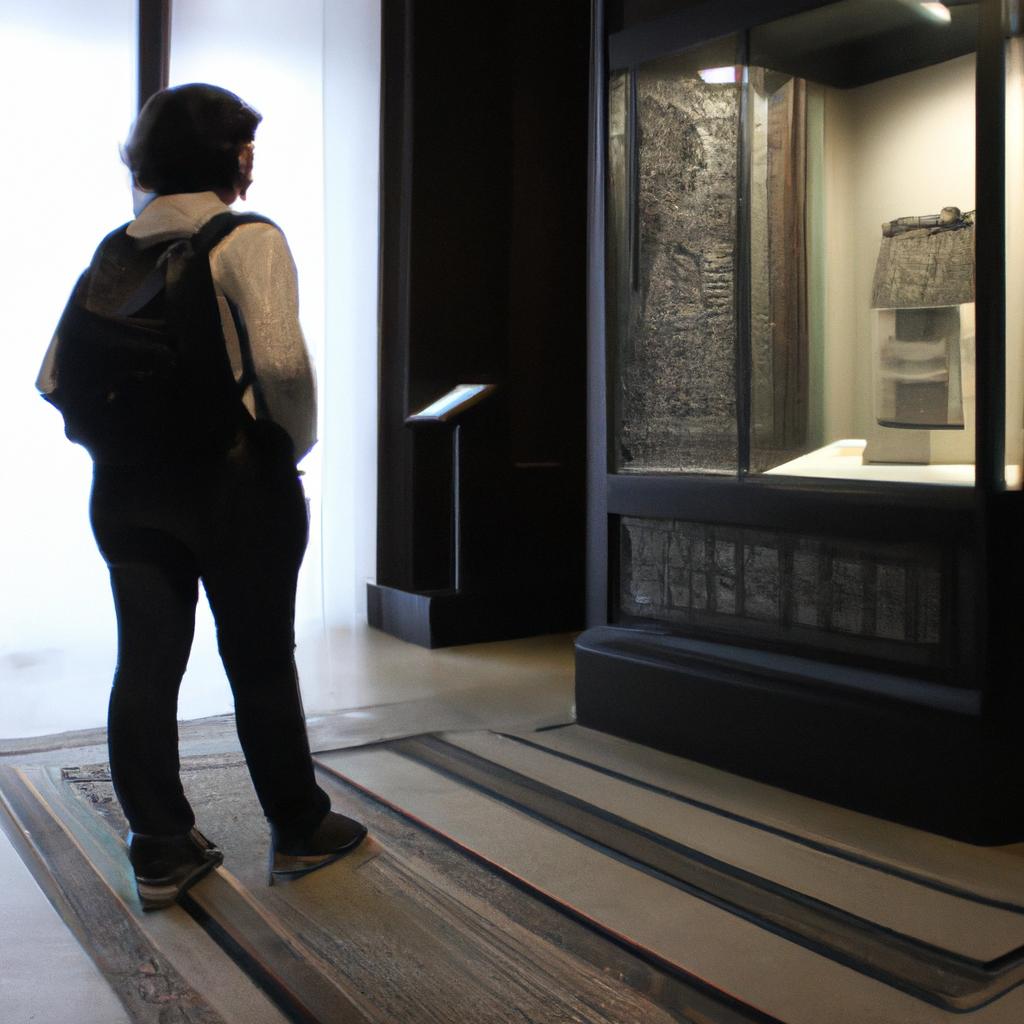Architecture plays a vital role in showcasing the cultural heritage of a region, and North America is home to a rich tapestry of architectural styles that reflect its diverse history and multicultural influences. From the ornate Victorian mansions of San Francisco’s Painted Ladies to the towering skyscrapers of New York City, each structure tells a unique story about the people who built it and the society they represented. Exploring these architectural treasures not only allows us to appreciate their aesthetic beauty but also provides insights into the historical, social, and cultural contexts that shaped them.
One captivating example that exemplifies this connection between architecture and cultural heritage is Monticello, Thomas Jefferson’s iconic estate located in Charlottesville, Virginia. This neoclassical masterpiece showcases both Jefferson’s personal vision of idealized architecture as well as his deep admiration for classical ideals such as symmetry, proportionality, and harmony. The construction of Monticello was influenced by various architectural styles including Palladianism and Roman classicism, resulting in a unique fusion that reflects Jefferson’s intellectual pursuits and philosophical beliefs. By delving into the design elements and historical significance of Monticello, we can unravel layers of American history while gaining valuable insight into one man’s aspirations for his new nation.
Architectural Influences in North America
Architecture in North America is a rich tapestry of influences from various cultures, showcasing the diverse history and heritage of this continent. One notable example that highlights these architectural influences is the iconic Château Frontenac in Quebec City, Canada. This majestic hotel, built in 1893, blends elements of French Renaissance architecture with medieval castles, creating a unique and captivating structure.
Throughout North America, architectural styles have been shaped by cultural exchanges between indigenous populations and European settlers. These interactions resulted in the emergence of distinct architectural forms such as Spanish Colonial Revival in California or Pueblo Revival in New Mexico. The fusion of these different design traditions reflects the complex history and multicultural nature of the region.
To evoke an emotional response from audiences when exploring the architectural influences in North America, consider the following:
- The transcendent beauty of Gothic cathedrals rising against modern cityscapes.
- The sense of awe inspired by intricate ornamentation adorning historic buildings.
- The nostalgia felt when discovering forgotten structures that tell stories of past eras.
- The wonder experienced when witnessing how architectural innovations push boundaries.
In addition to evoking emotions through words, visual aids can also engage readers on a deeper level. Consider this table highlighting four distinct architectural styles found across North America:
| Architectural Style | Originating Culture | Notable Examples |
|---|---|---|
| Spanish Colonial Revival | Spanish | San Juan Capistrano Mission (California) |
| Greek Revival | Ancient Greece | Parthenon (Nashville, Tennessee) |
| Art Deco | French | Chrysler Building (New York City) |
| Victorian Gothic | British | Notre-Dame Basilica (Montreal) |
As we delve into the next section about “Historic Landmarks: Preserving the Past,” it becomes clear that understanding these architectural influences is crucial for safeguarding our cultural heritage. By exploring the significance of historic buildings and landmarks, we can gain insights into the past while appreciating their enduring relevance in the present.
Historic Landmarks: Preserving the Past
Architectural Influences in North America have played a significant role in shaping the cultural heritage of the region. From colonial times to present day, diverse architectural styles and influences have left their mark on the landscape, reflecting the rich history and multiculturalism prevalent throughout North America. To further explore this interplay between architecture and culture, it is important to delve into specific examples that highlight the profound impact of architectural design.
One such example is the historic district of Charleston, South Carolina. With its cobblestone streets and well-preserved antebellum homes, Charleston showcases a unique blend of architectural influences from various periods. The city’s iconic Rainbow Row features row houses painted in vibrant pastel hues, reminiscent of Caribbean aesthetics brought by British colonizers. This fusion of European and Caribbean elements not only adds visual appeal but also serves as a reminder of the region’s complex historical background.
When examining North American architecture through a cultural lens, several key themes emerge:
- Preservation: Historic landmarks serve as tangible reminders of our shared cultural heritage, fostering a sense of pride and identity.
- Adaptation: Architectural styles evolve over time to accommodate changing needs and societal values.
- Symbolism: Buildings often incorporate symbolic elements that reflect regional identities or commemorate important events.
- Cultural Exchange: Architecture becomes a medium through which different cultures influence one another, resulting in unique hybrid forms.
To illustrate these themes more clearly, consider the following table showcasing notable architectural landmarks across North America:
| Landmark | Location | Architectural Style |
|---|---|---|
| The Alamo | San Antonio, TX | Spanish Mission |
| Château Frontenac | Quebec City, QC | French Renaissance |
| Empire State Building | New York City, NY | Art Deco |
| Fallingwater | Mill Run, PA | Organic Architecture |
Each landmark represents a different cultural influence, reflecting the diversity and history of the region. It is through these architectural treasures that we can gain a deeper understanding of North America’s cultural heritage.
In moving forward to explore Architectural Styles as a reflection of society, it becomes evident that architectural design not only shapes our physical environment but also mirrors societal values and aspirations. From grand neoclassical government buildings symbolizing power and authority to sleek modernist structures embodying progress and innovation, architecture serves as a visual representation of the zeitgeist. By examining architectural styles prevalent in different eras, one can uncover layers of social, political, and economic dynamics embedded within the built environment.
Architectural Styles: A Reflection of Society
Having explored the significance of historic landmarks in preserving cultural heritage, we now turn our attention to the various architectural styles that have emerged throughout history. These styles not only serve as a reflection of society but also play an integral role in shaping the identity of different communities across North America.
Architecture has always been a powerful medium through which societies express their values and aspirations. From grand cathedrals to humble cottages, each structure tells a story about the people who built it and the era in which it was created. To illustrate this point, let us consider one example – the Guggenheim Museum in New York City. Designed by renowned architect Frank Lloyd Wright, this iconic building is an embodiment of modernist architecture with its unique spiral form, challenging conventional notions of museum design.
Architectural styles not only reflect societal values but also shape them in return. They influence how individuals perceive their surroundings and interact with their environment. The impact can be observed through several key aspects:
-
Symbolism: Architectural styles often incorporate symbols that hold deep meaning for a particular community or culture. For instance, Gothic architecture commonly features pointed arches and ribbed vaults, symbolizing spirituality and transcendence.
-
Functionality: Different architectural styles prioritize specific functions based on societal needs. Consider the efficient layout and innovative use of space found in Bauhaus buildings, reflecting the movement’s emphasis on functionality over ornamentation.
-
Cultural Identity: Architecture serves as a physical manifestation of cultural identity, representing shared traditions and beliefs within a community. Traditional Native American dwellings like adobe houses or longhouses are prime examples that showcase indigenous cultures’ close connection to nature and harmony.
-
Social Change: Architectural styles evolve alongside social change, mirroring shifts in society’s priorities and ideologies. Brutalist architecture emerged during the post-war era, reflecting a desire for practicality and honesty in design while challenging previous notions of beauty.
Table: Architectural Styles and Their Significance
| Architectural Style | Significance |
|---|---|
| Gothic | Spiritual |
| Bauhaus | Functionality |
| Native American | Cultural Identity |
| Brutalist | Social Change |
In conclusion, architectural styles are not just aesthetic choices; they hold significant cultural and societal value. They reflect the aspirations, values, and identity of communities throughout history. By understanding these architectural styles, we gain insight into how societies shape their built environment as well as how architecture plays a role in shaping collective consciousness.
Moving forward, we will explore the role of architecture in shaping identity within North America. Understanding how different architectural styles contribute to the formation of regional identities allows us to appreciate the rich tapestry of culture across this diverse continent.
The Role of Architecture in Shaping Identity
The architectural styles found in different regions can provide valuable insights into the cultural heritage and identity of a place. By examining these styles, we gain a deeper understanding of how societies have evolved over time and how their values and aspirations are reflected in the built environment. This section explores the significance of architectural styles as a reflection of society and highlights their role in shaping cultural identity.
One compelling example that demonstrates the connection between architecture and culture is the preservation efforts surrounding Charleston, South Carolina. Known for its historic charm, this city showcases various architectural styles ranging from Georgian to Federal to Greek Revival. Each style represents a distinct era in American history, reflecting not only changing tastes but also societal values such as wealth, power, and influence.
To further appreciate the impact of architectural styles on cultural identity, consider the following points:
- Architecture as an expression: Architectural styles serve as visual representations of cultural values, traditions, and historical events.
- Symbolism through design elements: Different architectural features such as columns, arches, or decorative motifs carry symbolic meanings tied to specific cultures or historical periods.
- Preservation challenges: Maintaining historical buildings requires significant effort due to factors like weathering, urban development pressures, and limited resources.
- Economic implications: Historic architecture often attracts tourism and boosts local economies by creating jobs related to restoration projects or promoting heritage tourism.
By observing these bullet points closely, one realizes that architecture extends beyond just physical structures; it holds within it stories that shape our collective sense of self. To illustrate this relationship further, consider the table below showcasing examples of iconic architectural styles around North America:
| Region | Architectural Style | Key Features |
|---|---|---|
| New England | Colonial | Symmetrical facades with central chimneys |
| Southwest | Pueblo | Adobe construction |
| Quebec | French Canadian | Steep roofs and dormer windows |
| Pacific NW | Craftsman | Exposed wooden beams and natural materials |
Through the preservation of these architectural styles, we not only honor our past but also create a sense of continuity that bridges generations. By recognizing the cultural significance attached to these structures, we are reminded of their enduring importance in shaping our collective identity.
Transitioning into the subsequent section on the Cultural Significance of Architectural Preservation, it becomes evident that understanding and preserving architectural heritage is crucial for maintaining a connection to our roots and fostering a sense of belonging. This leads us to explore how architecture plays an integral role in safeguarding cultural traditions and enriching communities.
Cultural Significance of Architectural Preservation
Architecture plays a pivotal role in shaping the identity of societies and communities. By examining architectural structures, we can uncover various aspects of cultural heritage that have been preserved throughout history. One example that exemplifies this is the preservation and restoration of historic buildings in cities such as Charleston, South Carolina.
In preserving its architectural heritage, Charleston has managed to maintain its distinct character and charm. The city’s commitment to protecting its historical landmarks, such as Rainbow Row with its iconic pastel-colored houses, showcases the significance of architecture in defining a sense of place. These well-preserved structures serve as tangible reminders of the city’s rich history and cultural legacy.
When considering the cultural significance of architectural preservation, several key points emerge:
- Architectural styles reflect the values and beliefs of a particular era or society.
- Historic buildings provide a physical connection to our past, fostering a deeper understanding and appreciation for our shared heritage.
- Preservation efforts contribute to sustainable development by revitalizing neighborhoods and promoting tourism.
- Architectural conservation serves as an important educational tool, allowing future generations to learn about their ancestors’ way of life.
To further emphasize these points, let us examine a table highlighting different elements within architectural preservation:
| Elements | Emotional Response |
|---|---|
| Historical authenticity | A sense of pride and nostalgia |
| Conservation efforts | Hope for future generations |
| Revitalization projects | Excitement for urban renewal |
| Heritage tourism | Cultural exploration |
As we delve into the significance of architectural preservation, it becomes evident that architecture acts as more than just bricks-and-mortar; it represents the collective memory and spirit of a community. Taking care to preserve these structures not only safeguards our cultural heritage but also allows us to appreciate how our predecessors lived their lives.
Transitioning seamlessly into the subsequent section on “Architecture as a Window into North American History,” one cannot overlook how architecture provides valuable insights into the historical development of North America. By examining architectural styles, construction techniques, and spatial arrangements, we can gain a deeper understanding of the social, economic, and political forces that have shaped our continent’s history.
Architecture as a Window into North American History
Building on the cultural significance of architectural preservation, exploring different architectural styles and structures can provide us with valuable insights into the rich history of North America. By examining notable examples such as the Grand Central Terminal in New York City, we can uncover how architecture serves as a window into the past.
Architecture not only reflects societal values but also plays a significant role in shaping them. Take, for instance, the Grand Central Terminal, an iconic transportation hub that epitomizes both historical and cultural importance. Constructed in 1913, this Beaux-Arts style building showcases exquisite design elements and meticulous attention to detail. Its cavernous Main Concourse, adorned with celestial-themed ceiling murals and opulent chandeliers, evokes a sense of grandeur and elegance reminiscent of an era long gone. This architectural masterpiece stands as a testament to the ambition and vision of its creators while embodying the spirit of progress during a time when rail travel was at its peak.
Exploring architecture across North America reveals four key aspects that evoke an emotional response among visitors:
- Preservation: Architectural landmarks uphold our collective memory by preserving physical remnants of bygone eras.
- Identity: Buildings often serve as symbols representing local communities’ unique identities, reflecting their history, culture, and values.
- Aesthetic Pleasure: The beauty found in architectural designs captivates viewers’ senses, providing moments of awe-inspiring wonderment.
- Connection to Heritage: Architectural heritage connects individuals to their roots and fosters a deeper understanding of their ancestors’ experiences.
To illustrate further how architecture acts as a conduit to history, consider Table 1 below showcasing three distinct architectural styles prominent throughout North America’s development:
Table 1:
| Style | Description | Key Examples |
|---|---|---|
| Colonial Revival | Inspired by early American colonial architecture, characterized by symmetrical facades | Monticello, Boston Common |
| Art Deco | Influenced by geometric shapes and lavish ornamentation of the 1920s and 1930s | Empire State Building |
| Modernist | Emphasizes functionality and simplicity while incorporating innovative materials and designs | Fallingwater, Seagram Tower |
Exploring these architectural styles not only provides a visual delight but also offers insights into different periods. By recognizing the historical contexts in which these buildings were constructed, we gain a deeper appreciation for their significance.
In summary, delving into North America’s architectural history reveals how structures like the Grand Central Terminal serve as windows to the past. The emotional response evoked by preservation efforts, the representation of identity, aesthetic pleasure derived from architectural beauty, and connection to heritage strengthen our understanding of cultural legacy. Through an exploration of various architectural styles prevalent across the continent, we can unravel fascinating stories that contribute to our collective narrative.
 Island Gourmet Safaris
Island Gourmet Safaris



